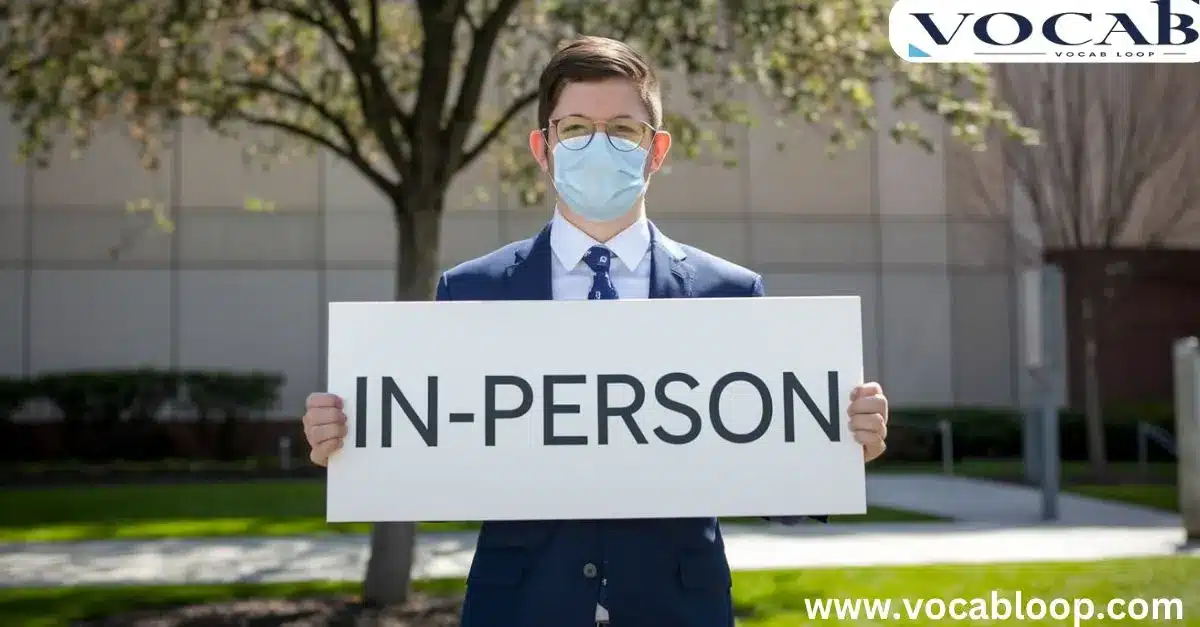Understanding when to use “in person” or”in-person” can make a significant difference in your professional writing. In today’s world, where communication shifts between virtual and face-to-face interactions, knowing the correct usage is crucial. This comprehensive guide will clarify the distinctions between these commonly confused terms, helping you maintain clarity in all your written communication.
Whether you’re drafting business emails, creating event descriptions, or writing formal documents, mastering these terms will enhance your professional image and ensure your message is conveyed accurately.
Definition and Meaning
- In Person (adverb):
Refers to physically being present at a location rather than communicating remotely or virtually.- Example: “She delivered the speech in person.”
- In-Person (adjective):
Describes activities, meetings, or events that require someone’s physical presence.- Example: “The in-person interview went smoothly.”
The understanding of these terms centers around their grammatical roles in communication. Modern usage has evolved with the rise of virtual and hybrid work environments, making the distinction more important than ever. These terms help us clearly differentiate between physical presence and remote interaction.
The evolution of language and professional writing standards has shaped how we use these terms. With the increasing blend of virtual and face-to-face meetings, knowing the proper usage helps maintain clarity in both casual and formal settings.
In Person:

The term “in person” functions as an adverbial phrase, describing how an action takes place. This form appears naturally in conversation when discussing physical presence at an event or meeting. Think of it as answering the question “how?” something happens.
The usage of “in person” flows naturally in sentences where you’re describing the manner of an action. Consider it similar to phrases like “by hand” or “in full,” where the words work together to explain how something occurs.
In-Person:

When hyphenated, “in-person” serves as a compound adjective that modifies nouns in your sentences. This form creates clear descriptions of events, meetings, or activities happening face-to-face. The hyphen connects the words to form a single modifying unit.
This terminology becomes particularly important in formal communication and business writing. The hyphenated form helps prevent ambiguity and maintains professional standards in written documents.
Which One is More Acceptable and Correct
In contemporary writing style, both forms are correct when used appropriately. The key lies in understanding their distinct functions. The unhyphenated form works for describing actions, while the hyphenated version modifies nouns.
Professional style guides like the Chicago Manual of Style and AP Stylebook provide clear guidelines for these distinctions. Their recommendations help maintain consistency and effectiveness in professional communication.
What is the Correct Way to Write In Person?
The correct usage depends entirely on the context and function within your sentence. When describing how something happens, use “in person” without the hyphen. For modifying nouns, use “in-person” with the hyphen.
Style experts and grammarians agree that clarity comes from consistent application of these rules. Your choice should always serve the purpose of clear communication.
What is the Difference Between In and On Person?

The preposition choice creates significant distinctions in meaning. While “in person” refers to physical presence, the phrase “on person” typically relates to carrying something on one’s body. This understanding helps avoid common confusion in everyday usage.
Languages evolve through typical usage, and these prepositions have developed clear roles in modern English. The clarity of your message depends on choosing the right preposition for your intended meaning.
How Do You Say Meeting In Person?
Professional writing offers various ways to express face-to-face meetings. Common phrases include “Let’s meet in person,” “I’d like to schedule an in-person meeting,” or “Can we arrange a face-to-face discussion?” The key is maintaining clarity while expressing the desire for physical presence.
These practical examples show how context shapes our word choice. Whether in formal business communication or casual settings, the goal remains clear understanding.
Which is Correct, In Person or In-Person?
This common question depends entirely on the word’s function in your sentence. Here’s a simple comparison table to guide your usage:
| Usage Type | Correct Form | Example |
| After Verb | in person | “We met in person” |
| Before Noun | in-person | “An in-person meeting” |
| As Description | in person | “She appeared in person” |
| As Modifier | in-person | “In-person classes” |
How Do You Ask Someone to Meet In-Person?
Requesting an in-person meeting requires professionalism, tact, and consideration of the other person’s schedule and preferences. Here are some tips and example phrases to help you ask effectively:
Tips for Asking to Meet In-Person
- Be Polite and Clear: Use courteous language to make your request sound professional and considerate.
- Provide Context: Explain why an in-person meeting is necessary or beneficial.
- Suggest Flexibility: Offer multiple time slots or locations to accommodate their schedule.
- Acknowledge Preference: Recognize their availability for virtual or in-person options.
- Emphasize Importance: Highlight the significance of the discussion requiring face-to-face interaction.
Example Phrases
- “Would it be possible to arrange an in-person meeting to discuss this further?”
- “This topic seems best suited for an in-person conversation. When would you be available?”
- “I believe meeting in person would help us address this matter more effectively. Can we find a time that works for you?”
- “Let’s set up an in-person discussion to ensure all details are covered. Are you available next week?”
- “Would you prefer an in-person meeting, or is a virtual session more convenient?”
When to Use In-Person Requests
- For sensitive topics that require privacy or nuance.
- Complex discussions involving physical materials or demonstrations.
- Networking or relationship-building opportunities.
By framing your request in a thoughtful manner, you convey professionalism and respect for the other person’s time and preferences.
In Person or In-Person Quiz: Expanded Information
Testing your understanding of “in person” versus “in-person” is a great way to solidify proper usage. Below are scenarios and tips to deepen your learning:
Advanced Scenarios
- The CEO prefers (in person/in-person) meetings to build rapport with employees.
- Correct Answer: in-person
- Explanation: The hyphen is used because it modifies “meetings.”
- Due to unforeseen circumstances, we cannot attend the event (in person/in-person).
- Correct Answer: in person
- Explanation: It describes how attendance is occurring, functioning as an adverbial phrase.
- The feedback session will transition from virtual to (in person/in-person) mode.
- Correct Answer: in-person
- Explanation: “In-person” modifies “mode” as an adjective.
- The professor advised us to submit our projects (in person/in-person).
- Correct Answer: in person
- Explanation: This describes the manner of submission, functioning as an adverb.
Quiz Tips
- Remember that “in person” follows action verbs to describe the how of an action.
- Use “in-person” before nouns when describing the nature of the meeting, event, or action.
Interactive Practice
To reinforce learning, consider online grammar tools or quizzes that provide immediate feedback. Practicing with real-world examples, like business emails or event announcements, helps contextualize usage.
Side by Side Comparison of In Person or In-Person
Understanding these terms through direct comparison helps clarify their proper usage:
| Aspect | In Person | In-Person |
| Function | Adverbial phrase | Adjective |
| Position | After verbs | Before nouns |
| Purpose | Describes action | Modifies nouns |
| Example Usage | “Let’s talk in person” | “An in-person event” |
Synonyms of In Person or In-Person
In Person Synonyms:
Formal/Professional Contexts:
- Face-to-face
- On-site
- In attendance
- In the flesh
- Physical presence
Casual/Everyday Usage:
- In real life (IRL)
- Up close
- In person-to-person
- Directly
Business/Meetings Context:
- On-location
- Live
- Present physically
In-Person Synonyms:
Formal/Professional Alternatives:
- Face-to-face (e.g., “face-to-face meetings”)
- On-site (e.g., “on-site interview”)
- Physical (e.g., “physical interaction”)
- In attendance (e.g., “in-attendance consultation”)
- Live (e.g., “live session”)
Casual Alternatives:
- Real-life (e.g., “real-life meetup”)
- Up-close (e.g., “up-close interaction”)
- Direct (e.g., “direct conversation”)
Origins of In Person or In-Person

In Person Origins:
The terminology of “in person” traces back to legal and formal communication contexts. Originally stemming from Latin “in persona,” this term emerged in English during the 15th century. Its primary purpose was to distinguish physical presence from representation by proxy in legal proceedings.
In-Person Origins:
The hyphenated form “in-person” developed much later, emerging prominently in the 20th century. This evolution reflected the growing need for precise writing style in business and professional contexts. The rise of telecommunication made it increasingly important to specify when interaction happened face-to-face.
Uses in Context
The following section provides real-world practical examples demonstrating proper usage in various scenarios.
In Person Examples:
- The candidate delivered their presentation in person.
- We should discuss this matter in person.
- The celebrity appeared in person at the premiere.
- Students must submit their assignments in person.
- The contract needs to be signed in person.
- She always pays her bills in person.
- The artwork looks more impressive in person.
- They prefer to shop in person.
- The witness testified in person.
- Let’s resolve this issue in person.
In-Person Examples:
- The in-person workshop filled quickly.
- All in-person meetings are scheduled for Tuesday.
- Their in-person services receive high ratings.
- The in-person training begins tomorrow.
- We’ve resumed in-person classes.
- The in-person interview went well.
- They offer in-person consultations.
- The in-person experience differs significantly.
- Our in-person attendance policy changed.
- The in-person event exceeded expectations.
5 FAQs
Does virtual communication affect how we use these terms?
Modern communication platforms have actually strengthened the importance of distinguishing between virtual and in-person interaction. The terms help clarify the mode of meeting or event.
What about hybrid events?
For hybrid scenarios, specify the attendance type clearly: “The conference offers both in-person and virtual attendance options.” This maintains clarity in modern professional settings.
Should email signatures include the hyphen?
When referring to meeting preferences in email signatures, use “in-person meetings available” as it functions as an adjective modifying “meetings.”
How do style guides different on usage?
Most professional style guides agree on the basic distinctions, though some offer specific guidance for specialized scenarios. The fundamental rules remain consistent across major style guides.
What about casual writing?
While casual communication might be more relaxed, maintaining proper usage helps avoid confusion and demonstrates attention to detail in your writing style.
Conclusion
The proper use of “in person” and “in-person” reflects your attention to detail in professional writing. Remember: use “in person” as an adverbial phrase to describe how something happens, and “in-person” as an adjective before nouns.
This understanding becomes increasingly important as we navigate both virtual and face-to-face interactions. By applying these guidelines consistently, you’ll maintain clarity and professionalism in all your communications, whether in business documents, emails, or casual correspondence.

Alex Hormozi is a seasoned blogger at Vocab Loop, known for his deep insights into language, vocabulary, and grammar. With years of experience in writing, Alex shares practical tips and effective strategies to help readers improve their linguistic skills and enhance their writing abilities.

